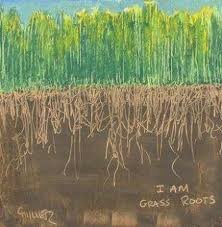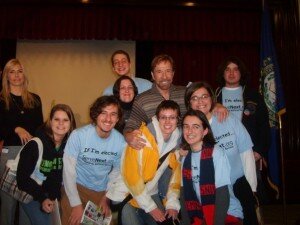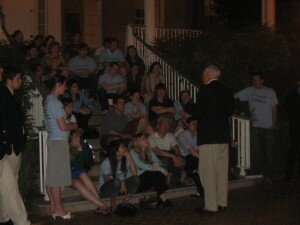A couple friends and I have been exchanging emails over the past few days about volunteerism and its ability to solve social problems.
The conversation began when one of my friends sent out an email asking if we had seen the article/excerpt from a book called “The Soul of a Citizen: Volunteering Can’t Solve Our Problems.”
After reading the article, I at first became a little bitter.
I thought – what a very limited view of volunteering! Volunteers can solve problems! In fact, it is our business to solve community problems.
The excerpt focuses on the failure of volunteer efforts to address the causes of social issues and the author suggests that we need to add a layer – “witness” – to our volunteering in order to leverage our good deeds for large scale social change.
Furthermore, the article implies that too often volunteer efforts treat the symptoms and not the root of social issues.
 To illustrate this point, the article resurfaces an old story of community impact.
To illustrate this point, the article resurfaces an old story of community impact.
In the story, some friends are having a picnic next to a beautiful river and suddenly a baby floats past them.
They wade into the current and rescue it, but then they notice there are dozens – hundreds – thousands of babies floating down the river.
The question is, should they put all of their resources into saving the floating babies, or should they take some of those resources and put together a re-con team to go up the river and find out where all the babies are coming from?
When they head upriver and find an ogre tossing in babies, should they let it continue to wreak its havoc, or try to stop it?
The book excerpt asks the question, what if the ogre (or root cause of the problem) is our government or the private sector?
As the article states,
“I’ve seen too many compassionate individuals trying to stem rivers of need, while national political and economic leaders have opened the floodgates to widen them.”
It’s a nice story, and one that speaks to splitting our efforts between direct service and advocacy – but, I don’t think we – or the author – can ignore the multitudes of skills-based volunteers and self-organizing innovators who are already addressing issues far beyond direct service.
My friends and I think that volunteers already have a place at the heart of social change.
Many nonprofit ventures are started as all-volunteer operations – imagining and implementing solutions to problems large and small, global and local.
These volunteers already know that they can make a difference and move the needle on issues like poverty, discrimination, hunger, human rights, and other societal issues.
After my friends and I debated on this issue for a while we agreed on the following major ideas:
First, volunteers need to be better advocates.
Advocacy is a big part of being a volunteer leader and teaching others to advocate for themselves is as equally important.
We also need to embed advocacy into volunteer training. This is what Loeb means by being a witness – described as
“taking these examples and lessons to the village square–or its contemporary equivalent–and then doing our best to convey them to as many others as possible. It means we must refute myths that justify callousness and withdrawal. It also implies that we do all we can to help those who are habitually ignored or silenced to find their own voices and platforms…”
As volunteers and service leaders, we need to get better at telling our story so that the public doesn’t simply see volunteers as feeding the hungry and clothing the poor but also as those who are working on all levels to create lasting social change.
We can’t let the mythology that volunteers are only good for fishing babies out of rivers stand unchallenged – we have the skills, knowledge, and ability to tackle the ogre, too!
We must have a multi-pronged approach to addressing social problems.
Of course we must treat the symptoms and address immediate needs of clothing, food, employment etc. but we also need to get involved in local government and teach others to do the same.
As my friends Rebecca and Melissa say,
“We must make sure that basic human needs are met. People can’t think about civic engagement when they’re worried about how to stay in their home or feed their kids. Once these are met then we can create a community around civic engagement and empower communities to use their own voice.”
 My friends an I also believe that volunteers and service leaders should try to work with existing organizations.
My friends an I also believe that volunteers and service leaders should try to work with existing organizations.
All too often, people have an idea and start their own club or organization.
There’s nothing wrong with being a self-starter, but if there’s an existing framework, joining that group is an instant way to engage those people who are already involved instead of splintering off into smaller and smaller fragments of community.
It’s important to remember that people crave a sense of community.
If civic engagement just adds to our already overwhelming to-do lists, no one is going to want to get involved.
Have a block party with your neighbors!
Share your ideas, plans and resources with the young couple across the street!
Once real relationships are established we can ask people to take on more responsibility, but the relationships have to come first.
Special thanks to my friends Melissa Sines and Rebecca Southers, who always challenge me and helped write this blog post.
 by Greg Heinrich, Alumni Mobilization Manager, AmeriCorps Alums
by Greg Heinrich, Alumni Mobilization Manager, AmeriCorps Alums In theory, the grasstops are integrally connected to the grassroots, but I have to wonder how much time a person who is influencing national policy – around youth civic engagement for instance- spends with the very people who are working day-in and day-out with those very same youth for which the policy is being crafted.
In theory, the grasstops are integrally connected to the grassroots, but I have to wonder how much time a person who is influencing national policy – around youth civic engagement for instance- spends with the very people who are working day-in and day-out with those very same youth for which the policy is being crafted.

 By Zach Maurin, Co-founder and Executive Director of
By Zach Maurin, Co-founder and Executive Director of  Field Corps will recruit, train, and support an annual cohort of community organizers to build and lead local networks.
Field Corps will recruit, train, and support an annual cohort of community organizers to build and lead local networks.

 To illustrate this point, the article resurfaces an old story of community impact.
To illustrate this point, the article resurfaces an old story of community impact.


